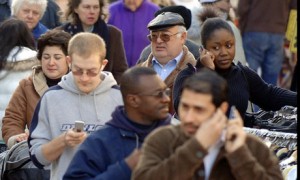Mobile phone use – a window on diversity

Photograph: Martin Godwin/guardian.co.uk
We once used behaviour around the hotel pool as a gauge of national temperament and characteristics.
But now, it seems, mobile phone use and etiquette has become the ultimate indicator of international idiosyncrasy.
A World Bank study has found the words used to describe the device and the social rules around its use vary markedly across cultures.
In the UK and Australia it’s called a “mobile”, in the US a “cell phone”, in Latin America a “cellular”, in Japan a “ketai” (portable), in China a “shou-ji” (hand machine), in Bangladesh a “muthophone” (phone in the palm of your hand), in Sweden a “nalle” (teddy bear), in Israel a “pelephone” (wonder phone) and in Germany a “handy”.
In social-harmony fixated Japan using a mobile phone in public is frowned upon and train commuters receive a barrage of recorded announcements telling them to switch their mobile to silent or vibrate – referred to as “manner mode”.
In contrast, the Spanish and Italians use their mobiles everywhere and are not averse to discussing their personal lives in public. The Spanish state-owned train company Renfe once promoted its journeys on a billboard showing the conversations people can have with their partners on mobiles from the train.
The Spanish and Italians happily answer calls in restaurants, during business meetings, conferences and even sometimes during concerts. Discreetly texting or instant messaging under the table during meetings is also commonplace.
But it is people in Finland, the homeland of Nokia, who are the chattiest on their mobiles in Europe, clocking up an average of 257 minutes a month.
Austrians follow closely behind the Finns at 240 minutes of use, while the Maltese spend the least time talking – an average of 46 minutes per month.
In parts of India and Africa, there has emerged a practice of split-second calls known as “flashing” or “beeping”.
The rules of beeping are simple: a person calls a mobile telephone number and then hangs up before the mobile’s owner can pick up the call. The mobile owner can then phone them back, thus picking up the tab for the call.
There are unwritten but deeply observed rules for “flashing”. When a mechanic wants to tell a customer his car is ready, for example, he can “flash” him.
The customer picks up the bill for the call. It’s also hierarchical: an employee calling a superior, who makes more money, is justified in “flashing” – unless he really needs a favour.
In India, few people have or use voicemail. And, a caller may get to hear a Bollywood song, chosen by the subscriber instead of a ringing tone. Known as caller tunes, the subscriber is charged for this monthly and they are very popular.
Similarly, in Africa, a caller might hear a quote from the Bible.
In both continents, it is also common for people to take calls inside a movie theater.
Indian society has a long tradition of tolerance, including in terms of allowing others to infringe on what those in the West would consider one’s personal space and this is why phone use in cinemas and crowded trains is tolerated.
In the US, a survey found that 72 per cent of Americans considered loud conversations in public places to be the worst habits of cell phone users.
The latest gripe appears to be iPhone users repeating simple questions to Apple’s robotic assistant. “Siri”.
The World Bank report found that more than three-quarters of the world’s inhabitants now have access to a mobile phone and the mobile communications story is moving to a new level, which is not so much about the phone but how it is used.
The number of mobile subscriptions in use worldwide, both pre-paid and post-paid, has grown from fewer than one billion in 2000 to more than seven billion now, of which nearly five billion are in developing countries.
Ownership of multiple subscriptions is becoming increasingly common, suggesting that their number will soon exceed that of the human population.
More than 30 billion mobile applications, or “apps,” were downloaded in 2011 – software that extends the capabilities of phones, for instance to become mobile wallets, navigational aids or price comparison tools.
In developing countries, citizens are increasingly using mobile phones to create new livelihoods and enhance their lifestyles, while governments are using them to improve service delivery and citizen feedback mechanisms.
“The mobile revolution is right at the start of its growth curve: mobile devices are becoming cheaper and more powerful while networks are doubling in bandwidth roughly every 18 months and expanding into rural areas,” said Tim Kelly, World Bank policy specialist and one of the authors of the report.
Laurie Nowell
AMES Senior Journalist












